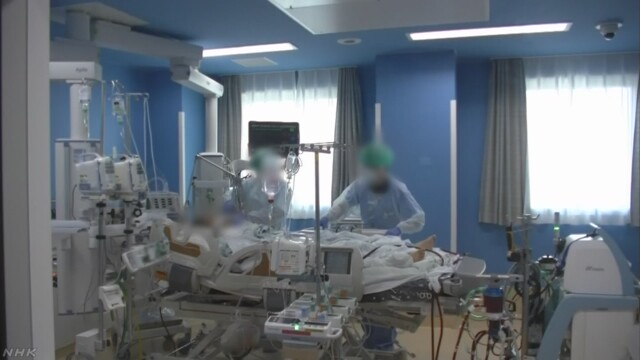Use of cardiopulmonary bypass due to worsening pneumonia At least 15 people nationwide
A professional societies survey showed that at least 15 patients with severe symptoms of exacerbated pneumonia caused by the new coronavirus were treated with cardiopulmonary bypass devices. Four of them are completing this treatment and are heading for recovery.
When infected with the new coronavirus, approximately 80% of people can be mildly affected by WHO, but about 6% of people have inflammation spread throughout the lungs and are said to have severe symptoms.
Because these patients are unable to take in oxygen, they receive treatment using an artificial heart-lung machine called ECMO, which sends oxygen directly into the blood to temporarily take over the function of the lungs. A survey of about 300 medical institutions nationwide by the Japanese Association for Emergency Medicine and others found that as of March 3, there were at least 15 patients alive with this treatment.
No new coronavirus has been confirmed to be effective, and according to the academic society, four people will wait until the virus is eliminated by the patient's own immunity while performing symptomatic treatment using ECMO. It means that you have finished treatment and are heading for recovery.
On the other hand, this treatment requires the judgment of an experienced physician, and the academic society will keep track of the number and use of ECMOs nationwide and move the patient to a hospital with a specialized physician. is.
Dr. Nobuhiro Takeda, who summarizes the treatment of ECMO at the conference, said that treatment with ECMO is very difficult and needs to be done properly. We want to strengthen our efforts to save as many patients as possible. You.
Resting weak lungs with ECMO and symptomatic treatment
One man in his 70s receiving treatment with ECMO, who had been tested for symptoms such as fever in the middle of last month, was found to be infected with the new coronavirus.
The man was hospitalized and was receiving medical treatment using a mechanical ventilator. However, his lung function deteriorated, and he switched to treatment using ECMO and continued this treatment for more than a week.
During treatment, blood is drawn from the body through a tube inserted through the neck, then oxygen is dissolved in place of the lungs using an ECMO device, and then returned to the body through a tube placed at the base of the foot.
According to the treating physician, about 4 liters of blood can be replaced in one minute, providing symptomatic treatment while resting a weakened lung and waiting for the virus to clear the body. That is.
In hospitals, specialized doctors and nurses check the condition of patients, such as whether blood clots have formed, and clinical technicians provide treatment 24 hours a day, responding to equipment problems.

